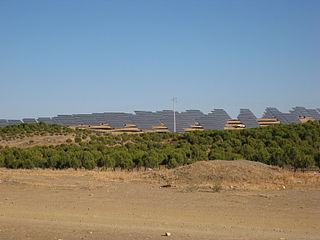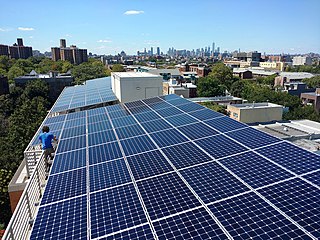
Nevada Solar One is a concentrated solar power plant, with a nominal capacity of 64 MW and maximum steam turbine power output up to 72 MW net (75 MW gross), spread over an area of 400 acres (160 ha). The projected CO2 emissions avoided is equivalent to taking approximately 20,000 cars off the road. The project required an investment of $266 million USD, and the project officially went into operation in June 2007. Electricity production is estimated to be 134 GWh (gigawatt hours) per year.

Iberdrola, S.A. is a Spanish multinational electric utility company based in Bilbao, Spain. It has around 40,000 employees and serves around 30 million customers.

Renewable energy progress in the European Union (EU) is driven by the European Commission's 2023 revision of the Renewable Energy Directive, which raises the EU's binding renewable energy target for 2030 to at least 42.5%, up from the previous target of 32%. Effective since November 20, 2023, across all EU countries, this directive aligns with broader climate objectives, including reducing greenhouse gas emissions by at least 55% by 2030 and achieving climate neutrality by 2050. Additionally, the Energy 2020 strategy exceeded its goals, with the EU achieving a 22.1% share of renewable energy in 2020, surpassing the 20% target.

Many countries and territories have installed significant solar power capacity into their electrical grids to supplement or provide an alternative to conventional energy sources. Solar power plants use one of two technologies:

The Waldpolenz Solar Park is a 52-megawatt (MW) photovoltaic power station built by German developer and operator Juwi at a former military air base near Leipzig, Eastern Germany. When completed by the end of 2008, it was the world's largest thin-film solar park using CdTe-modules.

Acciona Energía, a subsidiary of Acciona based in Madrid, is involved in the energy industry: the development and structuring of projects, engineering, construction, supply, operations, maintenance, asset management and management and sales of clean energy.

The Moura Photovoltaic Power Station is a large photovoltaic power station in Amareleja, in the municipality of Moura, Portugal. It is one of the largest power stations of its kind, and is built in one of the sunniest regions in Europe. Its construction involved two stages: stage 1 was completed in 2008 after 13 months, and stage 2 was completed in 2010. The entire project exceeded a total cost of €250 million.
The Rote Jahne Solar Park in Saxony, Germany, has a total output capacity of 6 megawatts peak (MWp). Built at a former military airfield, it has 90,000 First Solar thin-film modules covering approximately 6.7 hectares, and produces approximately 5.7 million kilowatt-hours (kW·h) of solar electricity every year. The project cost around Euro 21 million or US$28 million.

Solar power includes solar farms as well as local distributed generation, mostly on rooftops and increasingly from community solar arrays. In 2023, utility-scale solar power generated 164.5 terawatt-hours (TWh), or 3.9% of electricity in the United States. Total solar generation that year, including estimated small-scale photovoltaic generation, was 238 TWh.

EDF Renewables is a wholly owned subsidiary of the French utility EDF Group, specializing in renewable energy production. As an integrated operator, the Group develops and finances the construction of renewable energy facilities, and manages operations and maintenance for its own account and for third parties.

A photovoltaic power station, also known as a solar park, solar farm, or solar power plant, is a large-scale grid-connected photovoltaic power system designed for the supply of merchant power. They are different from most building-mounted and other decentralized solar power because they supply power at the utility level, rather than to a local user or users. Utility-scale solar is sometimes used to describe this type of project.

Solar power in Mexico has the potential to produce vast amounts of energy. 70% of the country has an insolation of greater than 4.5 kWh/m2/day. Using 15% efficient photovoltaics, a square 25 km (16 mi) on each side in the state of Chihuahua or the Sonoran Desert could supply all of Mexico's electricity.

Solar power in Florida has been increasing, as the cost of solar power systems using photovoltaics (PV) has decreased in recent years. Florida has low electricity costs compared with other states, which makes individual solar investment less attractive. Florida ranks ninth nationally in solar resource strength according to the National Renewable Energy Laboratory and tenth in solar generation by the Solar Energy Industries Association.

Solar power in South Africa includes photovoltaics (PV) as well as concentrated solar power (CSP). As of July 2024, South Africa had 2,287 MW of installed utility-scale PV solar power capacity in its grid, in addition to 5,791 MW of rooftop solar and 500 MW of CSP. Installed capacity is expected to reach 8,400 MW by 2030.
Solar power in Chile is an increasingly important source of energy. Total installed photovoltaic (PV) capacity in Chile reached 8.36 GW in 2023. Solar energy provided 19.9% of national electricity generation in Chile in 2023, compared to less than 0.1% in 2013.
Bucșani Solar Park is a large thin-film photovoltaic (PV) power system, built on a 24 ha plot of land located in Bucșani in Romania. The solar park has around 41,624 state-of-the-art thin film PV panels for a total nameplate capacity of 10-megawatts, and was finished in December 2013. The solar park is expected to supply around 18 GWh of electricity per year enough to power some 19,700 average homes.
Mount Signal Solar, also known as Imperial Valley Solar Project, is a 794 MWp (614 MWAC) photovoltaic power station west of Calexico, California, United States, in the southern Imperial Valley, near the Mexican border. The facility was developed and constructed by 8minutenergy Renewables in three phases, with two completed as of 2018, and the third in 2020. It is one of the world's largest PV solar farms with a capacity of about 800 MWp (600 MWAC). The project has been supported by several environmental groups, as the power station was built on low-productivity farmland.

Mohammed bin Rashid Al Maktoum Solar Park is a solar park spread over a total area of 77 km2 (30 sq mi) in Saih Al-Dahal, about 50 km (31 mi) south of the city of Dubai in the United Arab Emirates (UAE).

Benban Solar Park is a photovoltaic power station with a total capacity of 1650 MW nominal power which corresponds to an annual production of approximately 3.8 TWh. It is located in Benban in the western desert, approximately 650 km south of Cairo and 40 km northwest of Aswan. Benban is currently the 4th largest solar power plant in the world.

In Ukraine, the share of renewables within the total energy mix is less than 5%. In 2020 10% of electricity was generated from renewables; made up of 5% hydro, 4% wind, and 1% solar. Biomass provides renewable heat.

















